How To Create Better Content For Your Customers
Content is the new advertising.
According to Sprout Worth, over half of the most effective marketers put out new content for their readers at least several times a week, if not every single day. And, 70% of KISSmetric’s traffic is primarily from in-depth content that sits on Google’s top results pages. The best content will always win.
Your target audience is sick and tired of disruptive ads. They want something more valuable, rich and actionable. The content has to be digestible information, whether it’s presented in the form of an article, a blog post, an infographic, a video, memes, podcasts or a short report.
If you run a blog, your customers are most likely your readers. And, if you’re an information marketer, your customer is someone who interacts with you in a certain way, in order to buy your product or service.
No matter what business model you’ve chosen online, original and engaging content is still king. However, the way Google serves your web pages and content to the target audience significantly differs from how it did so in the past.
You need to develop a content marketing strategy and join the 27% of B2C entrepreneurs who aim to achieve a high ROI through their written content marketing plans.

These days, thanks to the Hummingbird algorithm change, when a user types a keyword (search query) into the search engine, Google uses over 200 ranking factors to determine and rank the most relevant results.
The algorithm still uses keywords, but there is something more powerful – searcher intent – more on that later in this article.
Download this step by step worksheet that will enable you to create content that your customers crave.
What is Content?
In web marketing, “content” simply means a piece of information that’s available electronically. As a rule of thumb, content should be interesting, challenging, entertaining and worthwhile. Otherwise, the producer (writer) has wasted his or her time.
Content creation is concerned with the research and production of different types of content that will attract a definite audience. No matter which style of blogging or writing you choose, make sure that you offer plenty of value.
On the other hand, content marketing is also about using the best tools out there to promote your valuable content, in order to attract and retain customers.
Content curation is an integral part of content marketing, too. Hundreds of thousands of great pieces of content never get seen and read. If you can find that content and make it easily accessible to your target audience, while adding your own unique flavor to it, you’ll stand out.

There is a huge demand for valuable content in every industry. But, it’s not always easy to produce the kind of content that gets noticed. In fact, 41% of the content marketing challenge is how to produce the kind of content that engages prospects and customers.

Content Creation Myths
The rate at which content is being created is ever-increasing. There are over 6.7 million people who blog on blogging sites (like Blogger.com & WordPress.com). What about self-hosted blogs and websites, like the one you’re reading now? See the live stats below:

Standing out from the crowd is the major goal. Can you acquire and retain customers easily? How can you come up with a content idea or topic that the people who matter most to your online business — that is, your prospects and customers — will respond to?
If that’s the reason you’re reading this article, I want you to stay put. First, however, let’s debunk some content creation myths, so you aren’t hampered by self-defeating ideas.
Myth #1: Content is for advertising. If you believe this lie, it’s time to take a different approach, because content is not always for advertising. In fact, your content shouldn’t be designed to sell directly to readers.
Content may well be the new ad, but your focus must be to create content that connects, interests and builds a communication relationship with your target audience. Content isn’t for direct selling, unless you’re a direct response copywriter.
Truth be told, most of the content that I’ve created so far hasn’t directly generated any leads or sales for me — but, in one way or another, I’m benefiting from that content.
Have a plan for every piece of content that you create. I like to provide value and usefulness in each article, blog post, video, infographic, etc., that I create. That should be your #1 priority.
Remember that when a potential customer is excited and finds satisfaction after reading or watching your content, a lot of good things will follow.
Myth #2: It’s about your company/you. I’ve seen a lot of brick-and-mortar businesses fall into this trap after establishing a web presence pinterest herunterladen.
In his classic book, It’s Not About You, Bob Burg explains that what matters most in your business is having the mindset of a customer and getting lost in their affairs. Matt Ambrose agrees – even your About page isn’t really about you at all!

Listen up: content should never be about you or your company. Of course, at some point, you may throw in some personal achievements or something worthwhile, but never dwell on that.
Make sure it appeals to your current target audience. And, write content that will help them, address their needs and improve their lives. Again: it’s not about you, but about the customer.
Myth #3: Quality content generates leads. Is this a myth or does it contain some element of truth? I think the latter is true. With quality content, some of the hurdles inherent in convincing prospects and customers to take your offer are eliminated.
HubSpot highlights the six reasons why great content fails. Just because your content is of high quality doesn’t mean it will generate leads for your business. That’s a mistaken belief. What about “marketing?” You also need a marketing strategy that works. Otherwise, you may fail, regardless of how useful your content is.

You need to understand your target audience and you need to create content that appeals to them. Most importantly, you MUST promote and market the content. If you fail to market the articles, videos, blog posts, podcasts and short reports that you create regularly, you will not succeed in online marketing.
The days of “write it and they will come” are long gone, if they were ever here to begin with. Don’t dwell on that. After all, the formula is:
content + marketing = qualified leads
Important Rule: Know Your Audience
No matter what title you hold in the inbound marketing field, you must have a detailed picture of your target audience, in order to create optimal and helpful content for it.
Do you know who your ideal customers are? What age brackets do they fall into? What about their income status, educational backgrounds, needs and wants?
These questions about your target audience will help you to develop a buyer persona.
That buyer persona forms the focus of your inbound marketing plan. It’s one of the key factors of success in content creation and marketing.
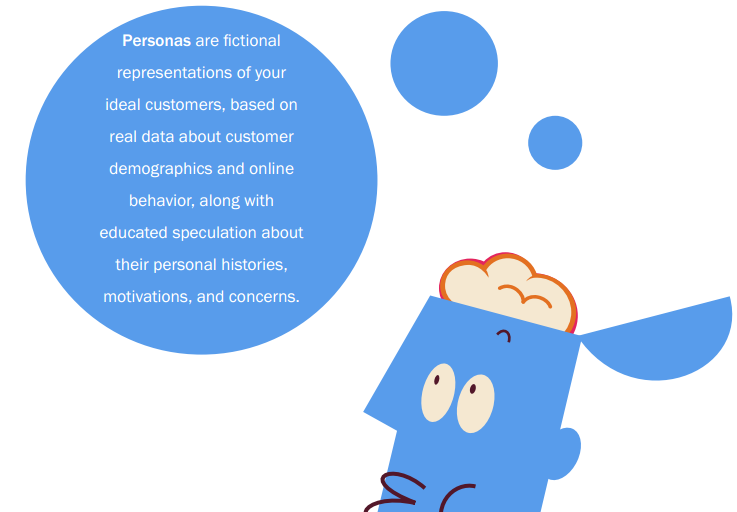
To understand your buyer persona, let’s use a simple tool that delivers quick results.
First: Go to Alexa.com. Type in your site URL (e.g. kickstarter.com). Then, click the “Go” button.
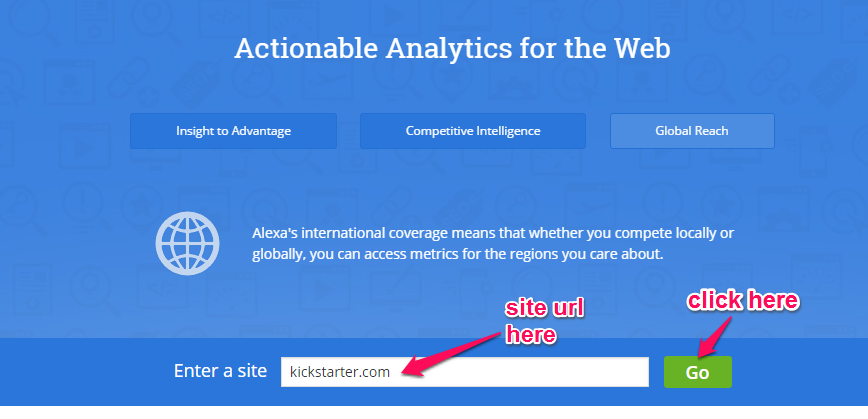
Next: Analyze the data. Scroll down the results page to check the audience demographics and engagement of your visitors.

From the screenshot above, you can see that Kickstarter’s target audience is 38% male and 62% female. The majority of these people have no college education. And, the average daily time spent on the site is 4:11.
This puts Kickstarter in a position to produce content in its basic form, without using jargon. They need to break down complicated topics and ideas and make them easily digestible, since the target audience is composed of people who are not highly educated.
However, bear in mind that education cuts across several terrains. I’m only analyzing the data from Alexa.
Note: The moment you understand your buyer persona, you can weave that into your content creation, as well as into all of your marketing. That’s how to hit a home run as a content marketer.
It’s time to dive into content creation more fully.
Listed below are the five steps that you need to take, in order to create better content for your customers:
Step #1: Brainstorming Ideas and Topics
Brainstorming is a creative effort to find the right conclusion to a specific problem or challenge. Brainstorming is much like switching on different light bulbs, to determine which one shines brightest.

For example, you can come up with ways to improve a particular marketing campaign. Brainstorming usually happens in a group or team of 8 – 13 persons. But, as a solo content marketer, you can adopt it, too.
Brainstorming helps you to generate ideas to solve a problem. Its purpose is to create an environment where the entire gamut of ideas — from “reasonable” to “quirky” — can be freely presented and discussed.
Although brainstorming may not be the best way to generate ideas for your project, it’s a great starting point. Once you lay out the problem that you want to solve, the rest will be easy.
Business Balls agrees that these seven steps must be taken when you’re brainstorming, whether it’s with a team or by yourself:
1). Define the objective and agree on it: What exactly do you want to achieve with your content? Do you want to generate traffic or attract qualified leads? Is it sales you’re concerned about? The definition step is complete when you (and other members of your team, if any) agree with the way that you’ve stated your goals and objectives.
As you define your objective, your creative instincts funnel will overflow holiday planner to. You will begin to generate powerful ideas for your content creation strategy.

2). Set a time limit for brainstorming ideas: If you’re brainstorming with your team, then set a time limit for each idea section. Brainstorming time disciplines you and your group (if any) to think creatively.

For example, you could set five minutes for thinking about your article headlines and strong user-oriented benefits. Setting a time limit for each brainstorming section is just as important when you’re brainstorming by yourself as it is when you’re working with a team.
Note: Make sure that you write down your thoughts, ideas and the time allotted for each brainstorming session. This ensures that you don’t forget your goals or exceed the boundaries that you’ve set for yourself and your team.
3). Refine your ideas: This is the step where you improve on ideas through small changes. For example, you could rewrite an idea or simply add something new to it. Just make it better.

4). Analyze the after-effects: After-effect is usually the secondary response to an idea that is the direct result of the primary response to that idea.
Remember that, in content creation, whether your content goes viral or not will be determined by the foundation or plan. According to Jeff Bullas, “39% of publishers want exclusive research.”
This means that you should spend adequate time on your topic research, before producing the content. Use survey tools, public APIs or networking to source data and facts that aren’t easily or freely accessible.
5). Prioritize a list of ideas: Next, you need to rank your ideas according to their importance. If you’ve brainstormed some ideas that are worth researching further, it’s time to prioritize them.

For example, if your ideas are:
Write headlines, use numbers on the headlines, start introduction with a question, write 5 subheadings, include data points, capture screenshots, mention industry experts, connect with A-list bloggers, conclude content with a call-to-action.
You could prioritize/rank them in this manner:
- Use numbers on the headlines
- Write headlines
- Start introduction with a question
- Include data points
- Write 5 subheadings
- Mention industry experts (their names or blog URLs)
- Capture screenshots
- Conclude content with a call to action
- Connect with A-list bloggers
Note: The ideas above are ranked in the order of importance. In other words, I’d rather “mention industry experts’ names or site URLs” in my content, instead of “capturing screenshots,” even though they’re both important.
6). Decide to take action: Your content creation requires a leap into the unknown. Intense feelings of desire can fuel your efforts to reach your goals. Launch your plan, get started and you’ll uncover some hidden gems in your content marketing journey.
Here’s what Nicholas Reese has to say about achieving success in your online business, especially as a content marketer.

Don’t wait for the right idea that looks or sounds heavenly. Start with the one that you’ve analyzed and prioritized.
7). Control and monitor follow-up: According to the U.S. Small Business Administration, “one of the ways to control your business effectively is to delegate and provide guidelines for others,” who will create content for you.
The time may not seem favorable to get started with delegating content creation, but just do it. Once the process is activated, it’s time to control and monitor follow-up. This is usually done when you have a team. But, you can equally monitor your own failures and successes.
Generally, if you want your content to hit the target audience hard and help you acquire clients who will ultimately become customers, follow these simple steps:
Think like a customer: Richard Branson, founder of Virgin Group says, “You can never go far wrong by thinking like a new customer.” But, what exactly does that mean?
Your customers are evolving. They’re the target of serious competition and they often don’t know what to do next. They’re being bombarded with advertising.
When you think like them, you let go of your ego, achievements, status and experience. You “walk in their shoes,” or “get into their heads.” That’s the essence of content marketing, which is usually a long-term strategy.
When you develop this mindset, you’ll ultimately provide great customer service and create content that appeals to your customers and solves their problems.
For example, it’s easy and fun to buy a great birthday present for your spouse, child or parent, because you know what they like. You wouldn’t want to offend them with a gift that sucks or that doesn’t suit them, would you? If you want to think like a customer, there are a few simple things that you should do:
a). Identify their pain points: What hurts your customers, every single day? This could be a challenge that seems insurmountable to them. The content you create should solve or address your customer’s pain points.

You’ll achieve tremendous results with your content when you think and act like a customer telekom ringtones for free. Graham Kenny discovered that “customers are better strategists than managers.” Your customer’s pain point could be a need, a problem, a desire or a challenge. As an example, 52% of social media marketers cited “how to calculate ROI” as their biggest pain point.

If you’re in the internet marketing industry, the most common pain points that customers face are:
- How to drive visitors to their blogs
- How to convert visitors to customers
- How to design a blog that loads fast
- How to write content that people love
- How to rank content pages in Google’s top results
- How to get a decent number of comments from real people
- How to write guest posts for a high-traffic blog
- And so on…
You can use digital analytics, online surveys and several other methods to extract information regarding your customer’s pain points.

Note: Depending on your niche, the customer’s pain points may differ. You can also use keyword research tools to find out exactly what these pain points are.
For example, you can use Ubersuggest to get regular web searches from your ideal customer. It’s easy.
Step one: Go to Ubersuggest. Type in a seed keyword (e.g. arthritis) and click “suggest.”
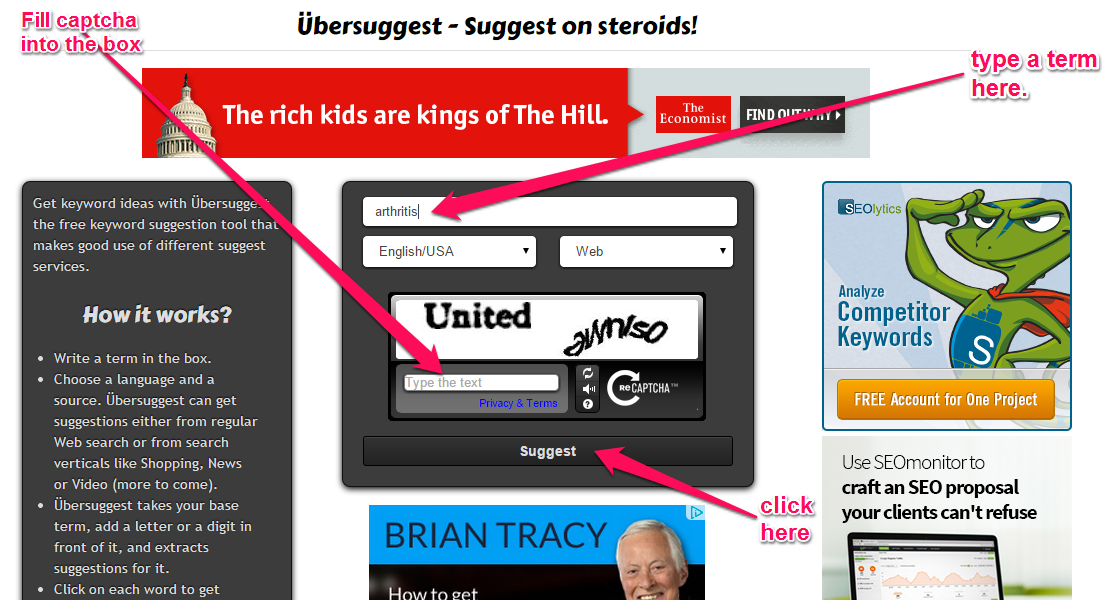
Step two: Pick the strongest customer pain points.

Step three: Expand on your strongest pain points. Click on your chosen keyword. You’ll get a drop-down list of results, showing you the long-tail customer pain points.
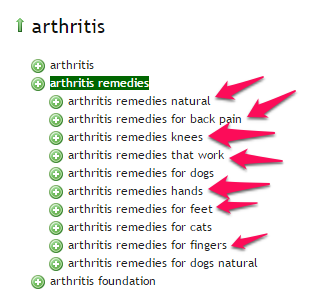
The keywords above are your customer’s pain points. If you can consistently research these popular search queries, you’ll not only write content that engages your target audience, but you’ll also improve your search rankings significantly through long-tail tail organic traffic.
Google will definitely reward long-tail SEO best practices. This is an aspect of searcher intent that became prominent, post-Hummingbird.

b). Follow your target customers: Another crucial aspect of thinking like a customer is to follow them, wherever they are. When you follow your targeted customers, they’ll feel important. And, you’ll see the profit potential even before creating enormous amounts of content.

Your customers don’t buy your goods or services in order to merely have that item or that service. In the same way, you don’t go out to eat merely to eat food, but for a certain experience that transcends eating at home. In both cases, you and your customers want to be treated like royalty.
I don’t just mean you should follow-up, which is very important, too. What I mean is that you should find out what interests your customers, where they hang out and how they interact — hen get into the conversation. Meet them at their point of need.
Most importantly, speak your customer’s language. Each customer should be treated differently. They hate to be treated as though they’re a part of a group. Remember that you don’t have customers. Instead, you have one customer at a time.
Customers should be treated well, as individuals with unique personalities distinct from the other customers of the same business. If you’re a B2C content marketer, you should always use the word “you” in your content.
When you address a customer with respect and the personal touch, they will love it and stick around on your site.
Pat Flynn once advised that you should “be everywhere,” if you want to reach your target customers wherever they are, without waiting for them to come to you.
Note: If you want your content to address a customer’s pain point easily, while you’re following them, then create different types of content. Keep in mind that not every target customer likes to read articles and blogs. Some prefer to watch videos or listen to podcasts while on the go.
Pat Flynn knows exactly how to address a customer’s pain points, using different content formats.
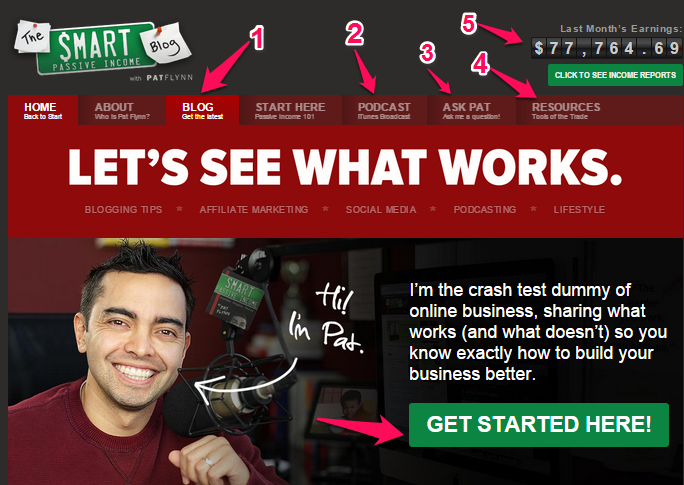
c). Communicate and relate with customers: Next, make sure that you follow-up with your customers. The more you communicate with and build a relationship with a customer, the more they’ll trust you. Branded content aimed at enhancing your personal or company presence online should be promoted, too. Above all, be consistent.
Of course, the best marketing tools for keeping in touch with your ideal audience are content and an email autoresponder solution.
I use Maropost, because it’s easy to use and has a lot of features and templates that work well for me. Other people use Infusionsoft, Aweber and MailChimp.
The choice is yours, but bear in mind that speed and reliability are the two factors that turn a great email marketing solution into an exceptional one videos from browser iphone.
An awesome website that knows how to communicate and treat a prospect or customer like a king or queen is Shopify. Their follow-up email series is rich and useful and their email subject lines are enticing.

Step #2: Long-Tail Keyword Research
According to Spark Inbound Marketing, getting found in Google’s top results depends on your ability to create plenty of quality content that helps search users.

They usually contain four or more words. For example:
- How to repair a broken camera lens
- I need help to lose weight
- Where to buy kindle fire HD
The long-tail keyword game (or “low-hanging search queries” as some people say) is one of the adventures that you should embark on this year.
Long-tail keywords can rank for several other seed keywords and generate more organic traffic than popular keywords.

If you have not been targeting long-tail keywords in your articles, blog posts, videos and short reports (which can actually rank well in Google), it’s time to get started.
1). Choose your seed keywords wisely: First of all, what is the primary keyword you’d like to rank for? Let’s assume you design websites for small businesses and would like to rank for “web designer.”
Be clear on the seed keyword that you select. Google will use that “seed” keyword to determine the theme or topic of your site. Next, let’s plug your seed keyword (“web designer”) into Google Keyword Planner and see what results come up.
First: After entering your seed keyword (e.g. web designer), scroll down the page and click “Get ideas.”
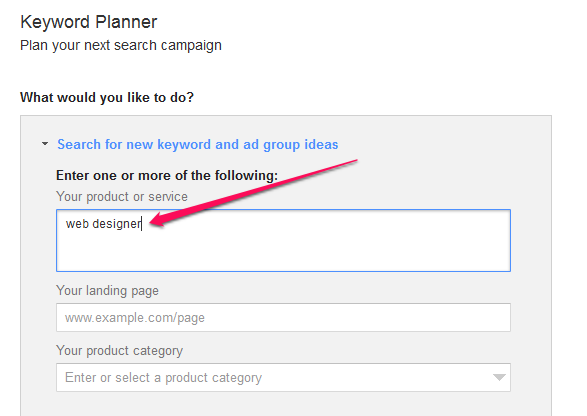
Second: Click on the “Keyword ideas” tab.

Third: From the suggested keywords, pick a keyword with a decent “Average Monthly Search” volume (at least 1,500 searches).

Fourth: Copy the keyword above (“web design new orleans”) and use it to generate long-tail keywords that will make it easier for your content to rank highly in Google results, as long as you provide in-depth and valuable content.
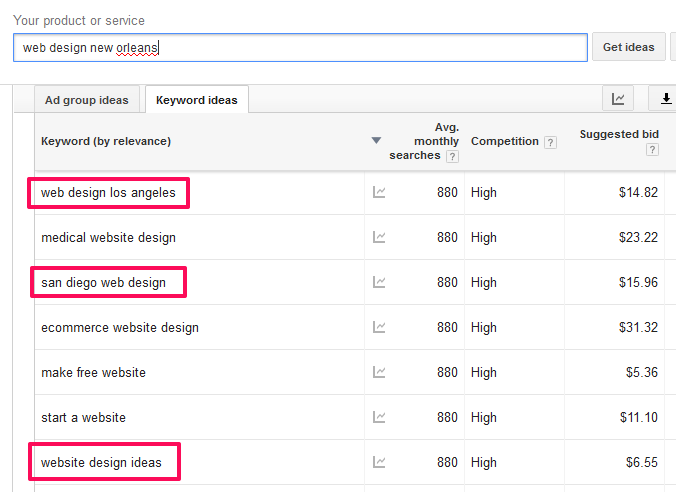
In the screenshot above, the long-tail keywords are:
- web design los angeles
- san diego web design
- web design ideas
Note that you can dig deeper into these keywords and come up with even more long-tail keywords. Just copy one of them. Plug it into the search box and hit “Get ideas,” again.

Admittedly, you may not generate a lot of search or referral traffic when you target the above queries, but you’ll acquire clients who will pay for your web design services (assuming that’s what you do).
This keyword research guide is not for web designers alone. It’s good advice for everyone who wants to build a business that will thrive.
2). Digging deeper into Google Keyword Planner: If you’re going to trust any keyword research tool, Google should be your #1. The reason is that prospects and customers use the search engine to look for highly useful information.
Apart from digging for different seed keywords in Google, you could just as easily reverse-engineer your research. How?
Go to Keyword Tool.io. Copy one of the keywords you generated from Google Keyword Planner and paste it in. Then, click the red search icon.
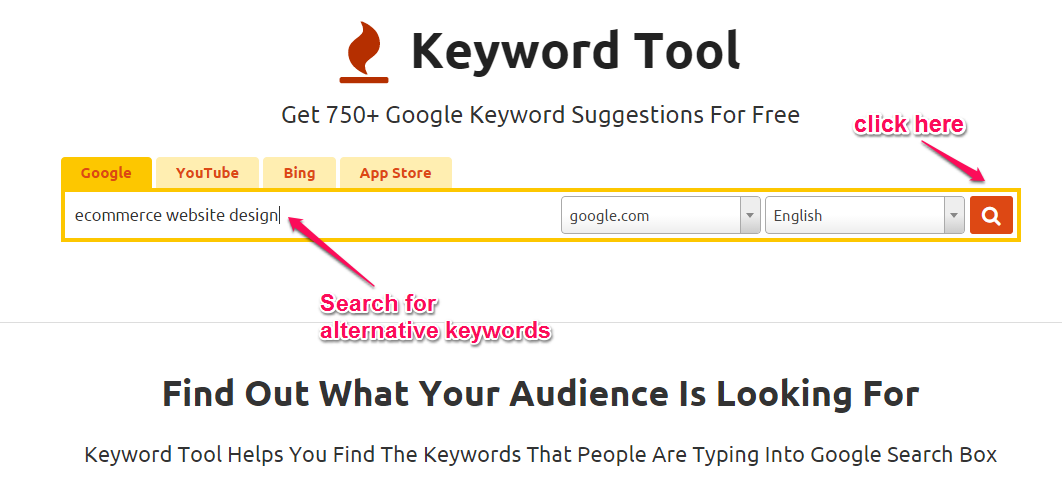
Next, pick your long-tail keywords. Now you have a lot less competition for content creation:
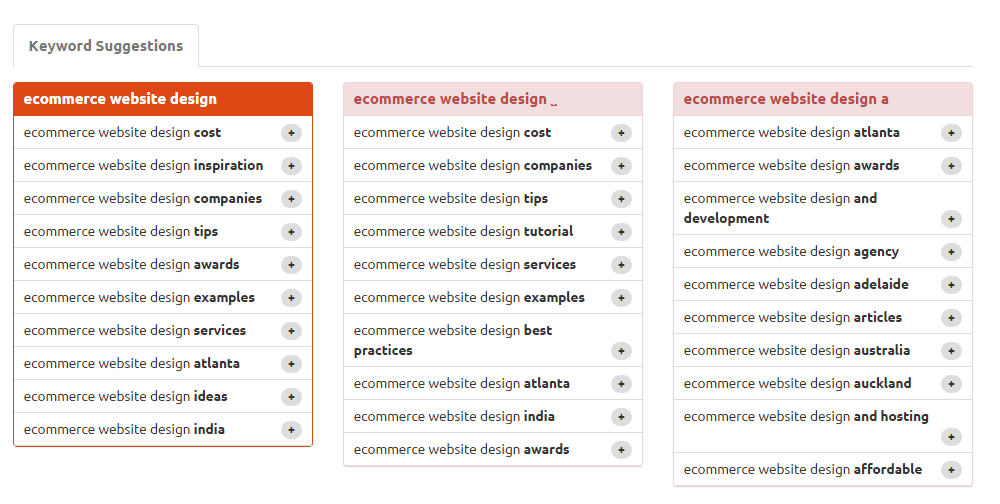
3). Identify long-tail commercial keywords: The SEO bar has been raised. If you’re going to succeed, you’ll need to target a particular user intent. User intent usually falls into one of two categories:
- Information intent
- Commercial intent
i). Information intent: When someone inputs this type of keyword into the search engine, they’re basically looking for free tutorials, guides, articles, videos or other types of content. In other words, they’re not looking to buy anything yet.
Here are examples of informational keywords:
- How to sew a shirt at home
- How to cure acne at home remedies
ii). Commercial keywords: As a content writer/creator, you can benefit a lot, if you target commercial keywords. Unlike informational keywords, commercial keywords are used with the sole aim of buying something or exchanging money for a solution.
Although you may not always write content to sell a product, you should spend some time crafting unique and helpful content around these “buyer keywords.”
So, how do you identify the commercial keywords that will generate profit (leads or money) for you?
Commercial keywords usually contain a prefix, suffix or qualifier, such as: reviews, best, fast, purchase, discount, deals, buy, order, comparison, top rated and so on.
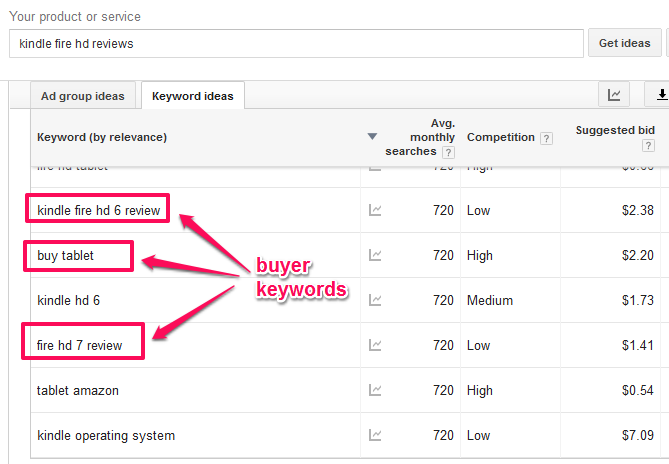
Step #3: Writing Attention-Grabbing Headlines
The headline is where readers start, according to Columbia University. Renowned copywriters agree that you should follow the 50/50 rule of headlines.
This rule states that you should spend half of the whole time you are writing the content on the headline. There are over 294 billion emails sent, per day and 2 million blog posts published on a daily basis. Everyone is desperately looking to gain attention.
But, that doesn’t mean that you should write pushy headlines to lure your readers tableau reader herunterladen. It doesn’t work.

Copyblogger Media says eight out of ten people will read your headline, but fewer than three out of ten will actually go past the headline and read the rest.
Which headline style works best? It’s hard to tell.
But, looking at the data from A-list bloggers and content marketers who have achieved tremendous success through blogging, I can show you some figures that may provide some tips.
Over the years, Michael Dunlop has advocated the usefulness and power of top list posts. He’s generated over 100,000 visits of free search traffic to his blog from exclusive top list posts.
Unbounce revealed that 36% of customers prefer and, as a result, engage more strongly with headlines that have numbers in them.

And, if an authority site is using “Top List” posts and adding numbers to their headlines, you know instantly that it will work. A great site to model is Lifehack.org. Around 86% of their blog posts have numbers in the headlines:

Headline writing tools: I like content marketing because I can easily leverage headline writing tools to make my work easier. Some of my favorite headline writing tools are:
- Ubersuggest: I walked you through the process of using Ubersuggest to generate content headline ideas based on a seed keyword that you typed in. If you’re stuck and don’t know what to write about or where to begin, this tool can help.
- Ntopic: If you want to boost rankings with statistically relevant content, Ntopic is a handy SEO tool. It will score your topic to determine whether or not your readers would respond to it. The higher the score, the better.
- Portent title maker: When I discovered this tool, I used it several times to generate titles and it actually worked well. But, as time went on, the platform became somewhat unstable. However, you should still check it out. Once you type in your subject, you’ll get a recommended title for your blog post.
- HubSpot’s blog topic generator: Any tool designed by HubSpot’s team will always deliver what it promises. Having used a lot of blog post headline generators, I can say that this is the BEST.
- Emotional Value Headline Analyzer: When you write headlines for your content, make sure that you appeal to reader’s emotions. No matter how rich, poor, sophisticated or naive humans beings may be, we’ll always be emotional beings. Use the “Emotional Value Headline Analyzer to measure the effectiveness of your headline before publishing your content.
- CoSchedule headline analyzer: I just discovered this tool and I’m loving it. Simply type your headline into the search box and click “Analyze Now.” This powerful tool will reveal the weak points in your headline and give suggestions on how to improve it.
- Buzzsumo: Have you used Buzzsumo recently? It doesn’t generate fresh headlines for you, per se, but it does analyze millions of headlines that received the most shares on Facebook, Twitter, LinkedIn, Google+ and Pinterest. Then, it presents them to you within five seconds. You can simply model a viral headline to create a magnetic one for your content.
Different headline writing styles that work: When it comes to writing headlines, the rules are not set in stone. Once you know who your ideal customer is and what their pain points are, you can literally crank out powerful headlines and content that will challenge them to take action. Listed below are some of the best headline writing styles that you may want to try out, in no particular order:
a). Question-based headlines: Upworthy currently generates over 88 million unique visitors per month. They take pride in asking emotional questions in their blog posts.

Eric Schmidt, CEO of Google, once said that Google, as a business, runs on questions. After all, the more questions you ask, the more answers you tend to get.
The same thing goes for your headlines.
Buzzfeed knows how to ask the right questions that will generate an instant response from fans.

How does this apply to you? If you’re a content marketer and your niche is internet marketing, here are some question-based headlines:
- What Does It Take To Get Your First 1,000 Email Subscribers?
- How Did You Make Your First $5,000 Online?
- Which Content Writing Tool Is Best For You?
- Have You Ever Written a Viral Blog Post Before?
- In the self-development niche:
- Can You Develop New Habits For Your Life?
- Do You Still Struggle To Quit Smoking?
- What Is Your #1 Pre-Workout Drink?
b). Case study headlines: If you offer a specialized service, the best route for attracting new clients is consistently publishing case studies or videos showing exactly what you did and the results that you got.
You could even share your failures and mistakes. Potential clients will appreciate honest information that comes straight from your heart.
Personally, I write case studies every other week. I’ve used it to grow my sales by 185%. The case study headline strategy works even better for me than question-based headlines.

And, my friend Brian Dean, founder of Backlinko, writes more case studies than any other type of headline or content:

It’s very easy to write case study headlines. Here are few ideas you can model:
- Case Study: The 3-Step Plan I Used To Drive 58,739 Visitors To My Site
- A Quick Guide: How I Finally Quit My Job And Built a Six Figure Online Business
- Step By Step: How I Researched Long-tail Keywords For My Authority Sites
c). Optimize your headline for users and searchbots: Significantly high search rankings don’t depend solely upon powerful headlines and accompanying content herunterladen. A lot of people that you want to reach still use search engines to search for information, whether they’re logged in or not.

This is the core reason why you need to optimize your headlines, as well as your content, for these searchers. As you create content for your customers, you’re faced with a challenge: How to write a headline that not only makes people want to click and read, but that also contains your targeted keywords.
Say your keyword is social media expert. You can model the headlines below. They’re all optimized for users, as well as for the searchbots.
- 5 Questions To Ask Before You Hire a Social Media Expert
- Social Media Expert: 13 Social Marketing Tips That Work
- How a Social Media Expert Should Approach Twitter Marketing
d). Model viral headlines and create a better one: Do you realize that the most successful content marketers really aren’t that special?
In fact, you may be smarter than them. But, what differentiates them from the struggling crowd is time. They take action immediately. They hate to procrastinate, which is why they’re often referred to as productive bloggers.
Follow this simple step to model viral headlines:
First step: Go to Buzzsumo.com. Type in your keyword (e.g. “content promotion”). Hit the “Go!” button.
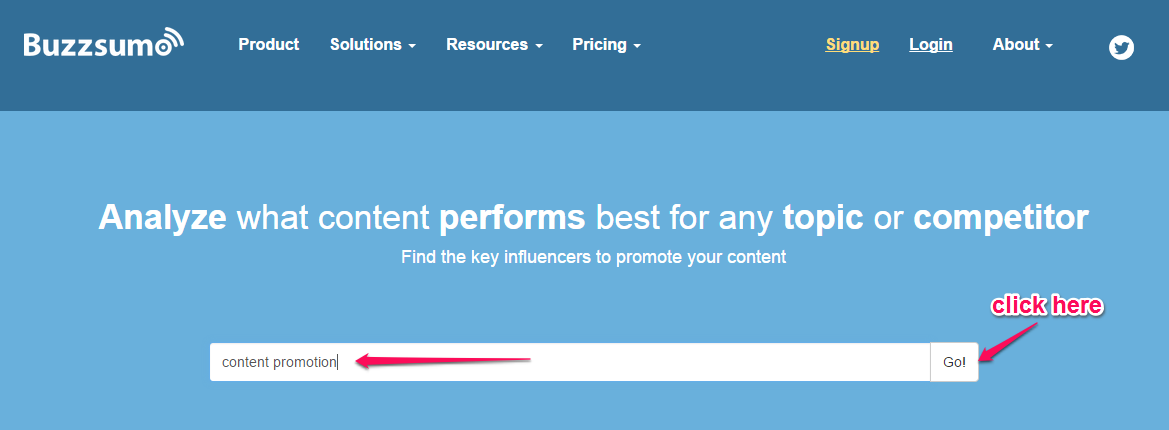
Second step: Analyze viral headline reach. How many shares does each headline have on Facebook, Twitter and other social media giants?

Looking at the screenshot above, you can see the three headlines that generated the most views and social shares in 2014. Can we craft a better headline than those examples?
Absolutely.
Original viral headline: 17 Advanced Methods for Promoting Your New Piece of Content
A more clickable and optimized headlines:
19 Smart Techniques For Promoting Your New Piece of Content
15 Surefire Methods For Promoting Your Content To 1000+ People
Sample viral headline:
No More Promotional Posts: Facebook Will Penalize More Brand Content
A benefit-driven and Google-friendly headlines:
Latest Update: Facebook Will Penalize Your Brand Content
How The New Facebook Algorithm Will Penalize Your Brand Content
Original viral headline:
5 Hacks for Creating and Promoting the Right Content
User-friendly and search optimized headlines:
7 Emotional Hacks for Writing and Promoting Valuable Content
13 Hacks for Producing Content That People Will Share
Step #4: Outsource content creation
Outsourcing your content creation simply means contracting or hiring an outside company to handle the project on your behalf. Outsourcing is growing at the speed of inflation.
According to Statistica, in 2008, the global outsourcing of services increased to $87.5 billion U.S. dollars. In 2014, that number had increased to $104.6 billion.
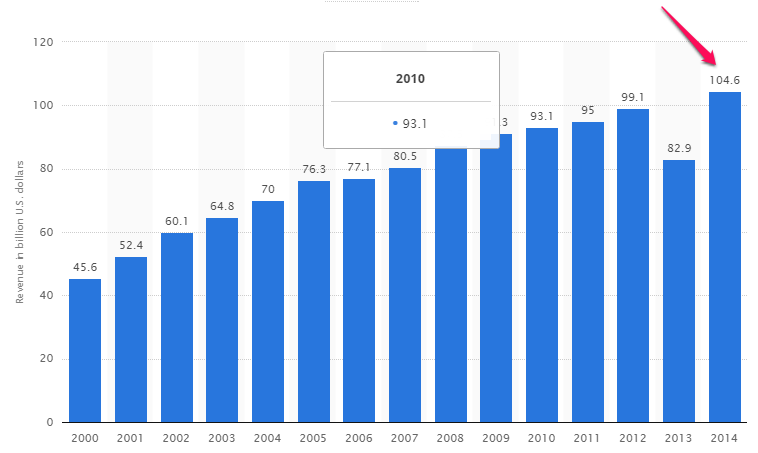
A lot of business entrepreneurs don’t yet understand how much outsourcing can actually increase their profit. If you spend so much time doing a particular task that you don’t enjoy, it’d be smarter on many levels to hire a professional to take care of that task.
When it comes to being consistent at content creation, give outsourcing a try. Better yet, you could work with an in-house writer who will learn and adapt to your content strategy.
For example, when I was creating my Advanced Guide Series, I couldn’t do everything myself, because each article is about 7,000 – 15,000 words long. And, I needed to cover several topics.
How to hire a professional content writer: Before you go out there to hire a freelance writer who will consistently create excellent content for you, lay some groundwork first.
a). Have a definite objective: If you can’t explain the objective you have for every piece of content that you create, then you’re not yet ready to hire someone.
Just like businesses develop an objective for their social media marketing efforts, blogging and content writing should also be aimed at a specific, pre-defined target.
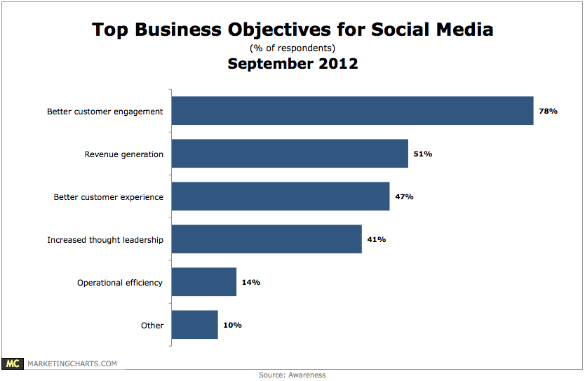
There are a lot of content writers out there. Some of them are trained to write for lead generation, while others know how to persuade and nurture a relationship with potential customers. Some writers, like SEO copywriters, know how to optimize for search engines as well as write copy that sells.
Your objective for creating a piece of content will guide you to the right solution. You’ll then know where your traffic is coming from and why people act the way they do on your site.

b). Set a budget: Investing in content creation and marketing is a worthwhile endeavor. In one survey, HubSpot documented that 71% of marketers were planning to work with an increased content marketing budget.
Over the next 12 months, Stipso predicts a significant growth in content marketing spending.

Before you hire a content writer (if that’s your choice), then save yourself considerable hassle and set a budget. This budget should be for the totality of marketing, not just writing articles.
Remember that 69% of digital marketing spending is going to content creation – because quality content is what prospects and customers want.
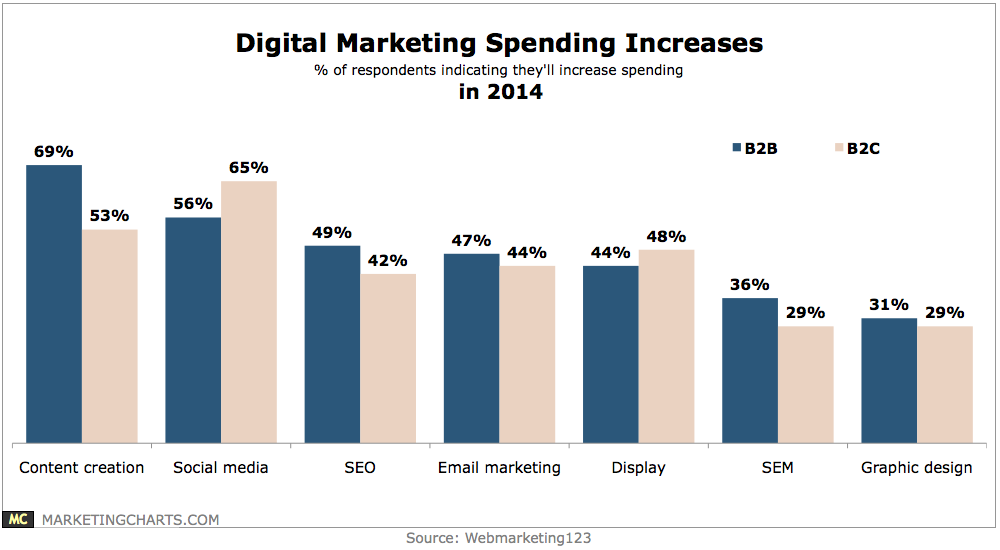
What to consider before hiring a writer: Although there are 10 things that you should consider before you hire a content writer, the most important thing is making sure that your ideal content writer is knowledgeable in your industry lufthansa ejournals. He or she should be able to create content that your prospects and customers all crave.

I can relate to this. If someone doesn’t have vast industry knowledge, the enthusiasm they need to achieve excellence will disappear.
Additionally, insist on hiring a writer who understands at least the basics of SEO. You don’t need someone who will stuff keywords, but they should understand meta tags, headings and subheadings, keywords and so on.
They must also understand crafting enticing headlines, persuasive copywriting techniques and proper grammar and spelling.
Passionate writers will help grow your business. If they’re not motivated, no matter what you do or how much you pay them, you won’t get the best content from them. Even if the writer completes a project, they’ll lack the enthusiasm to keep doing it again and again.
You see, passion keeps you doing the same type of work every single day. When you’re looking for a writer, make sure the person isn’t a newbie in the industry. If they’re beginners, their content could sound mediocre and might even get you penalized by Google, due to duplicate content.

Where to find and hire the best article writers: In most cases, content writers who are knowledgeable and highly skilled don’t hang out on job boards or submit proposals for job openings. You may have to go find them. You’ll want to check out their professional blogs or sites for details on how to contact them.
First: Go to Google. Type in a keyword + hire me (E.g. freelance writer + hire me).

Second: Visit the writer’s site and check out his samples. If you don’t find any samples, don’t bother contacting the writer, because the first impression isn’t very positive.
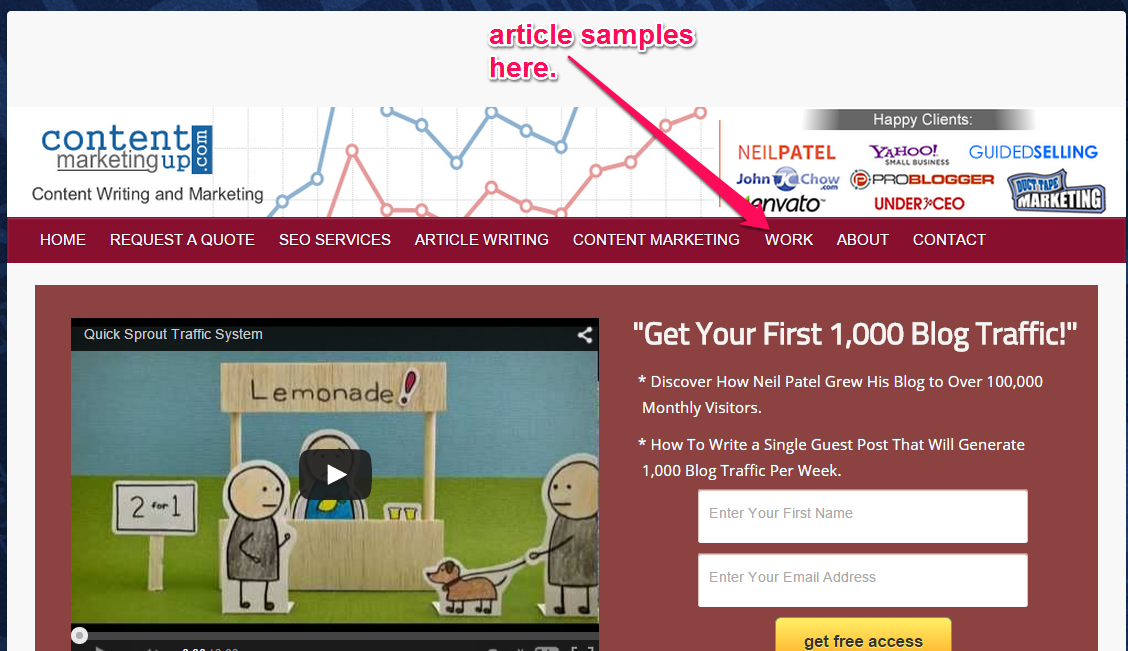
Note: Outsourcing content creation to another writer may be one of the best things that you could do to become productive. Most authority blogs use anywhere from five to 20 writers who specialize in different topics.
For example, Sitepoint has over 20 web development writers who create quality content related to HTML & CSS, design and UX, mobile, business and marketing, WordPress and so on. Sitepoint also accepts quality guest articles that will benefit their audience.

The end result of publishing high quality and practicable content regularly is obvious. Sitepoint now enjoys over 4 million readers per month and they’re still looking for more writers to join the team.

They understand that the more content they produce targeting searcher intent, the more search traffic they’ll generate from long-tail keywords.
You can also find quality writers from the Problogger Job Board. You have to post a job that will stay active for 30 days (1 month). It will cost you $50. A friend of mine received over 300 proposals from writers when he posted a writing project in August 2014.
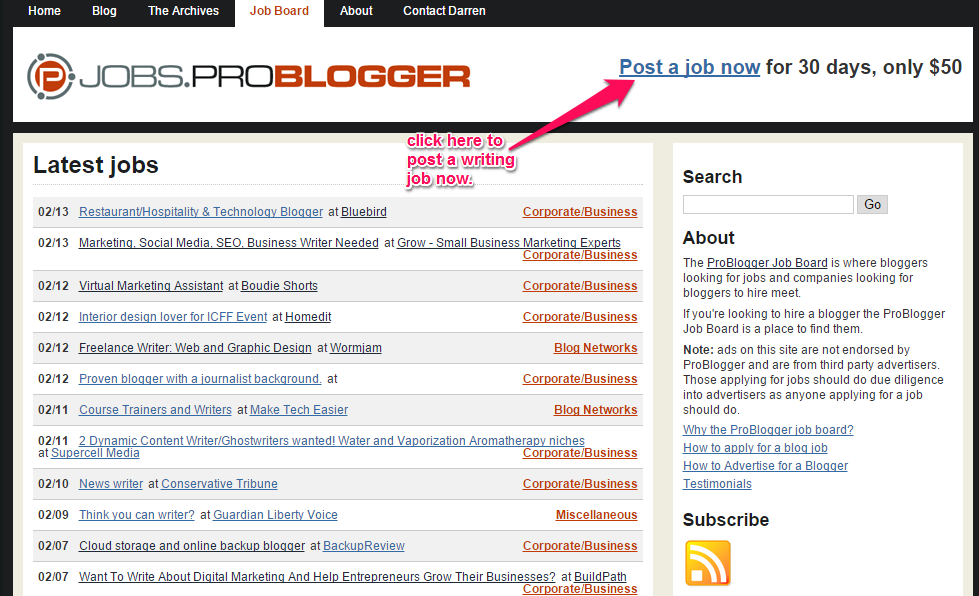
Note: There are several online job sites where you can also hire writers. Although I don’t use any of them, you may want to check out oDesk. When you invite professional writers with proven track records to apply for your writing job, you’ll get better content written at a reasonable price.
Follow these steps to hire a content writer at oDesk.
Step one: Go to oDesk.com. Type “content writer” in the search box and click the search icon.

Step two: Filter your search. You may want to find and hire content writers from a particular country (e.g. U.S. or U.K.). You should also set the category that you want.
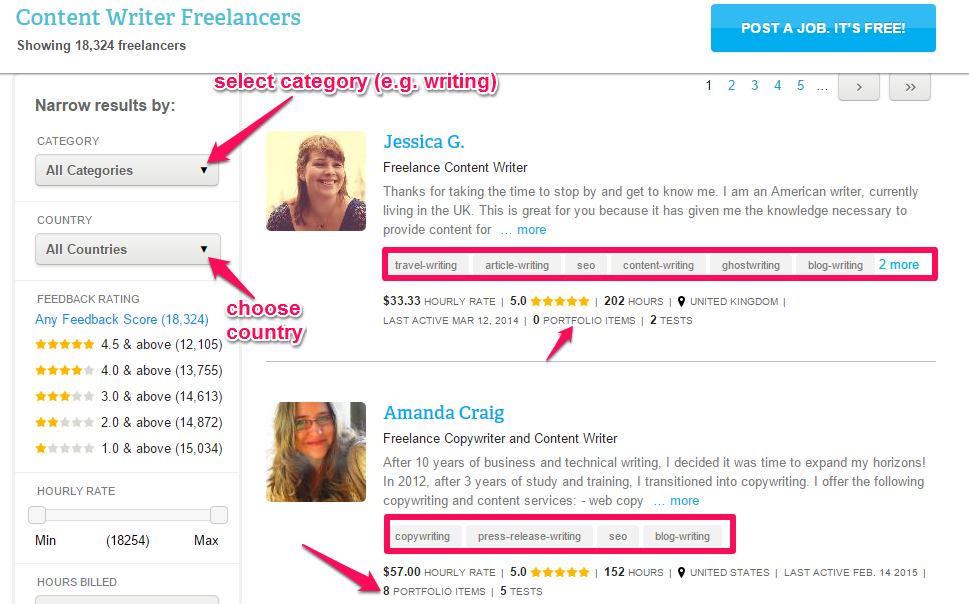
Step three: Explore a writer’s profile. Just click the writer picture or name and you’re in. You’ll want to find out their hourly rates, check out some samples (you must be registered on oDesk to do this) and learn more about the writer, before you hire him or her.
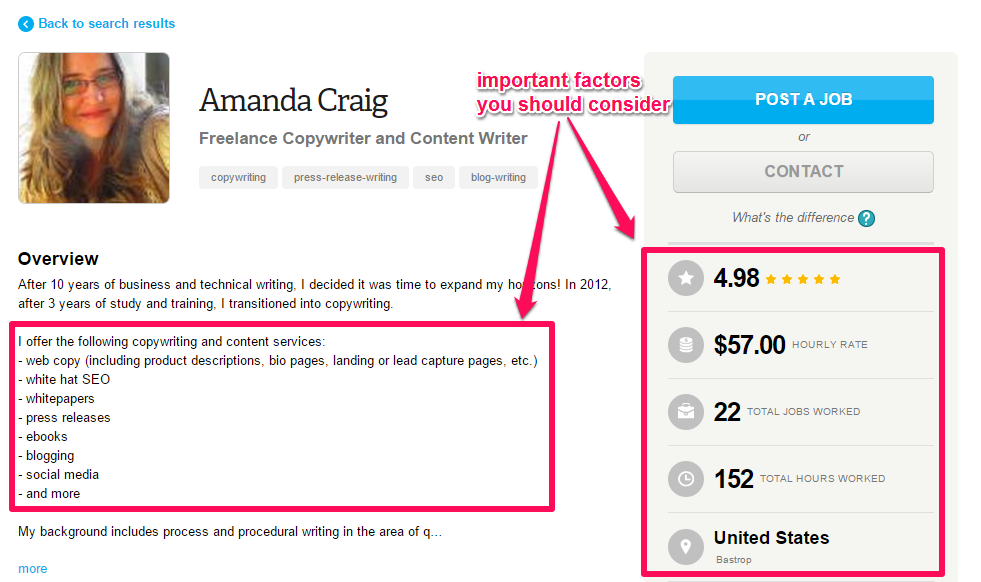
Step four: Contact the writer. This is the final step to hire this writer from oDesk, assuming you’re satisfied with her writing style, voice, portfolio, rate and personality.

Once you click on “contact,” you can easily assign your writing work to this person alone, which means that other content writers will not have access to it. The assignment is kept private.
Remember that in hiring a content writer, the most vital factor to consider is the practical knowledge and experience of the candidate. They may have an impressive portfolio, but if they aren’t enthusiastic to work with you and accept your “objective,” you may want to look elsewhere.
The industry rate for freelance writers: What’s the industry rate for freelance content writers? Most writers prefer to charge hourly, while others like a fixed contract rate. Find out the difference.

As a business owner — one who’s already set a content writing budget — you can save yourself some hassle by choosing a fixed rate. If you want creative writers to do the job right, you must expect to pay them the industry standard rates.
Admittedly, many freelance content writers have gone beyond the rates below. But, these are still the standard, as far as the digital industry is concerned:
- 500 – 700 word blog posts: $50 – $150
- 800 – 1,500 word article: $100 – $200
- 1,500 – 3000 word data-driven article: $250 – $400
- 3,000 – 10,000 word data-driven article: $500 – $1,000
Step #5: Promoting your content
The fifth step in making your content creation worthwhile is promotion funny ringtones for mobile for free. In outlining 17 advanced methods for promoting a piece of content, KISSmetrics suggests that you ask an influencer to share their own point of view, before you push the publish button.
It’s very simple to start a website or a blog. The real trick is attracting enough regular readers to meet your goals. The main goal of 25% of CEOs is to attract the right audience with every piece of information that they put out there.

If your site/blog is still new, it would be useless for you to aim for a top 10 ranking in Google. It’ll never happen.
Improving your search rankings is easier, once you have the right content and an active audience. But, for a new domain name with few or low-quality inbound links (from smaller sites with low Domain Authority and Page Authority), instant SERP domination isn’t a reasonable goal.
SEO is a long-term marketing approach. Be patient. Allow the Googlebots to crawl, index and determine the relevance of your web pages. Eventually, you’ll start ranking in Google.

Since your SEO efforts today will reward you with organic rankings and visitors tomorrow, you could then turn your attention towards promoting your content with these proven strategies:
Blog outreach: Blog outreach simply means reaching out to authority bloggers in your industry and building a relationship that eventually results in your content being read, cited and shared with other readers, prospects and customers.
It’s about getting across to the right people who have influence in the PR and social media space.

Developing a solid blog outreach strategy is one of the key ways that you can ensure a steady flow of visitors to your blog and acquire customers or clients. Blogging works. In fact, 61% of online shoppers have made a purchase based on a blogger’s recommendation.
Marmot highlights the core benefits of blog outreach, encouraging its prospects and clients to pursue it as a strategy:

But, the challenge that most content marketers face is getting the authors, webmasters, bloggers and editors to accept their content. An earlier study by Buzzstream and iAcquire revealed that the average placement rate for content is 4.5% – 4.8%.
In 2015, the percentage of content that will be shared will exceed that of previous years, because content writers are starting to see the potential in blog outreach. See the chart below for clarity:

Let’s use the FREPT model for blogger outreach to explain the 5-step process:

- Find
- Research
- Engage
- Pitch
- Track
i). Find: In the “FREPT” model, the first thing you have to do is find relevant and active blogs and bloggers to connect with. I write a lot of guest posts; finding the right blogs has always been easy for me.
A few of the factors that you should consider when looking to connect with a blogger or blog are:
- Make sure the blog has an active community. At a minimum, each post should receive a decent number of comments – e.g., Blogtyrant.com

- Make sure that the blog is active on major social media platforms (Facebook, Twitter, LinkedIn and Pinterest). Example: Problogger.net

- Connect with a blogger or entrepreneur who is well-respected in a specific industry – e.g., Derek Halpern, Socialtriggers.com.
- Ensure that the blog is updated at least once a week. That way, your content can be cited in weekly blog posts, sending you fresh visitors and leads – e.g., QuickSprout.com.
- Connect with bloggers who understand SEO and can optimize and promote a piece of content – e.g., AudienceBloom.com.
Now that you know the criteria to look for, here are some simple ways to find good candidate blogs for your outreach strategy:
Go to Google and type in the complete article headline that you want to promote and see which blogs have written quality blog posts on the topic. For example: How To Drive Qualified Traffic To A New Blog.

Note: Each of the results above is relevant to the search query and headline and is both user and Google-friendly. Looking at the headlines, you can see that the authors/bloggers behind these blogs are knowledgeable about SEO. Remember the criteria we listed above – these blogs and bloggers have it.
Next, click on any web page from the search results and explore the blog. Get to know the person(s) behind the blogs. Blogger outreach is simple, once you can understand (to a reasonable extent) the lifestyle of the person that you plan to connect with.

ii). Research: In this stage of blogger outreach, dig deeper into the blogs that you want your content to be promoted on. Type the blog URL into Open Site Explorer. We’ll use www.impactbnd.com in our example.
Take note of the DA and PA scores for the site. A Domain Authority of 40+ is what you should aim for. A Page Authority that’s above 30 is also nice.
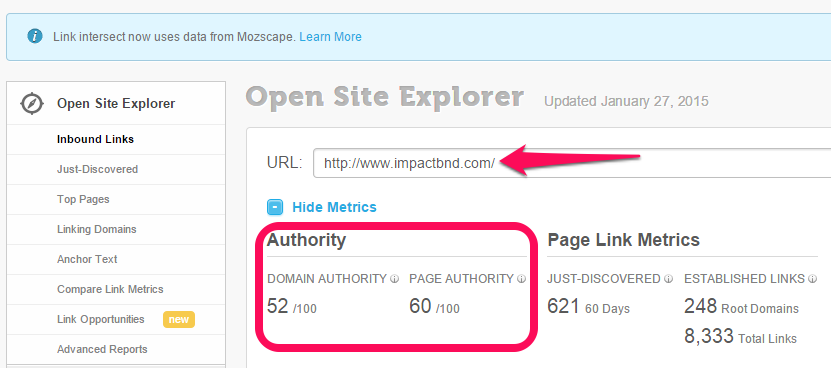
You can also use Twitonomy, a Twitter tracking tool to find influencers who have lots of loyal followers on Twitter. It’s important for you to connect to these people because just one retweet could send 500 – 1,000 visitors to your web page every day.
Getting started with this free tool is easy. All you need to do is to log in with your Twitter details. Next, look at the left-hand side of your dashboard, below your timeline.
You’ll find top influencers who have been active in the past hour downloaden firefox kostenlos. Some Twitter influencers aren’t as active currently as they were initially.
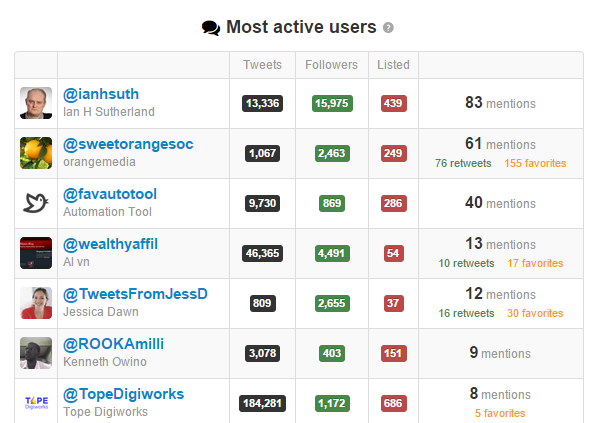
iii). Engage: This stage in the blogger outreach strategy for promoting your content is very important. You have to get involved in people’s affairs. You have to hold their attention and win their affection.
Finding influencers can be easier, if you have something valuable to give. Give first. Then, give again. You’ll be noticed. An influencer can reach more people faster, just by tweeting or sending a short newsletter.

The engagement rate is usually measured by the interactions that you initiated. You can engage with other blogs via emails, Facebook, Twitter, LinkedIn, groups, forums and so on. Email engagement is still higher than Facebook, but it’s important to initiate the conversation quietly.

For example, if you want to connect with Darren Rowse for the first time, knowing that direct contact may not be useful at this level, you may instead leave a significant comment on one of his blog posts, about 200 – 300 words in length, that offers something helpful to his readers.
Trust me, if you do this, Darren will notice you. And, if you’ve left your contact information (e.g., hyperlinking your name), you may get a response.
Once you connect with an influencer or authority blogger, you can gradually engage them through these means:
- Read their blog posts
- Write useful comments on their posts
- Share their content with your readers
- Cite their quote, result, or mistake in your content
- Like them on Facebook. Follow them on Twitter and repin their images on your Pinterest boards.
- Connect with them on LinkedIn
- Write a roundup article and include them near the beginning. That way, they’ll receive the most hits from your content.
- Join their insider email list. Buy their products.
- Tell them that you’re on their email list and prove it by sharing how much you enjoyed a specific piece of content in their newsletters or products.
iv). Pitch: If you’ve followed the simple steps as outlined in this post so far, you have connected with several influencers.
Understand that it’s not about you, but about the person you’re pitching to and connecting with. Whatever will make them happy and satisfied is your best shot.
Whether you’re pitching a new guest post, an idea, an already published piece of content or making a presentation to a group of investors, focus on how it can benefit the person that you’re addressing, not you.

You should always introduce yourself and what you do. But, trust me, if you’ve kept in touch with someone for up to 30 days, then you don’t need to introduce yourself again and again.
Influencers are very observant. If you regularly retweet their content on Twitter, that stands out.
And, they can support you when the need arises. You can always pitch your idea/content via email to someone who can help promote and build your brand online. Adam Connell, founder of Blogging Wizard, has this to say:
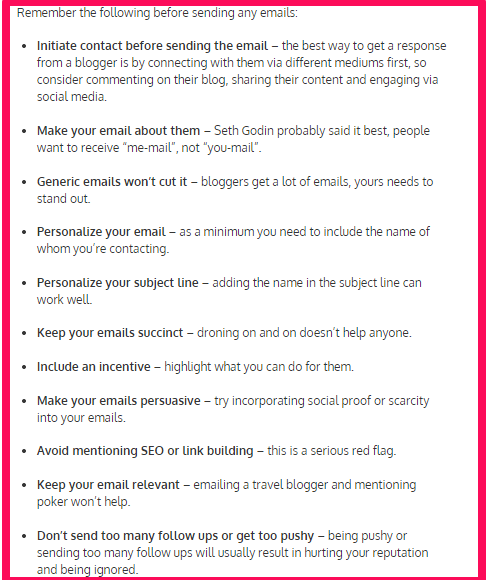
Depending on the reason why you’re pitching a blogger, you may want to model my own email template. Feel free to craft a better email from this. Add some personality and you’re good to go.
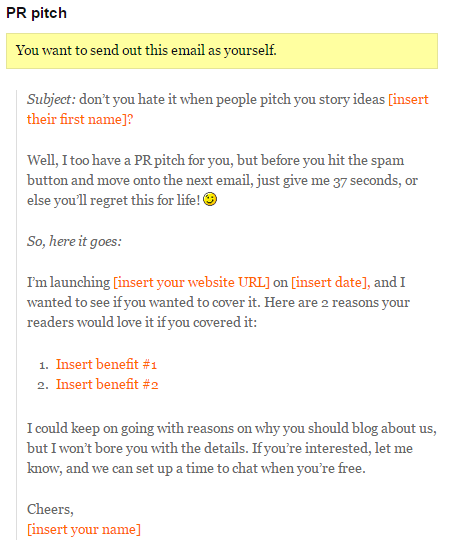
Find more pitch emails for guest blogging, link requests and broken link fixing at:
v). Track: When you send emails to bloggers asking for help with your content promotion, referrals and PR, do you know for sure how many people open that email?

It is easier to track if you are using Getresponse, Aweber or any of the autoresponder solutions out there.
But, when you’re pitching influencers and A-list bloggers, you want to do it manually through your GMail account. It’s a time consuming venture, to be sure.
One solution you can use is Yesware, a user-friendly GMail add-on that tracks your emails and tells you the exact time the recipient opened it. And, the premium account gives you more features about timing, as well as email marketing tips.

Conclusion
There you have it. The definitive guide to creating better content for your customers. Don’t forget that most of your customers will access and read your content on their mobile devices. Therefore, you’ve got to adopt a mobile responsive design for your blog or site as well.
Content marketing takes a piece of content that you’ve written and delivers it to the right audience, in a quiet, creative and professional manner.
Valuable content, like the article you’ve just read, will generate search traffic for your site through long-tail keywords and will also improve your brand and your sales, which is why 71% of marketers are increasing their content marketing investment.
As an online business owner, you know that selling is part of the formula. But, when you consistently produce great content that addresses a definite problem, you’ll sell more and win loyal customers in the process herunterladen.
Have you been acquiring leads and sales with high quality content?



